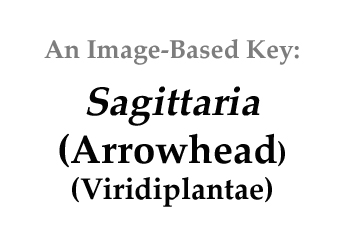|
Home / Anomalous_Items / Aquatic_Macrophytes / Emergent_Leaves / Sagittaria |
||||
|
|
||||
|
Click on images for larger format |
||||
Name derivation: |
||||
|
|
||||
Classification: |
||||
|
||||
|
||||
|
Flowers are imperfect, form a raceme, and are arranged in whorls of 2-12 on a floral stem.are trimerous. Male flowers have three white petals and three green sepals up to 2.5 – 4 cm diameter across petals, sometimes with dark red circles near their base, with 25-50 stamens in the center. The male flowers are short-lived (one day), and mature from base to apex of their raceme. Female flowers are located beneath males on the same stem and are easily distinguished by their lack of white petals and sphere of carpels. They mature ahead of the males. Round white or bluish tubers develop on rhizomes, as large as chicken eggs [online] that provide starch for beavers and muskrats. Can be cooked like potatoes or dried and ground into flour. Monoecious or dioecious. In southern Ontario, Canada, clones of both breeding types occur in S. latifolia, often in close proximity, with evidence of reduced self-pollination in dioecious clones even though their genomes were similar. Inbreeding depression was found in both monoecious and dioecious populations. No significant correlation between either geographic distance nor genetic distance was found in either sexual system. Based on inbreeding avoidance, strong evidence is presented for the evolution from monoecy to dioecy in plants – at least in S. latifolia (Dorken et al. 2002). Flowers are imperfect, pollination is mainly insectivorous including flies, bees, wasps, and butterflies (Ibid.). Roots are septate. |
||||
Similar genera: |
||||
|
|
||||
Habitat: |
||||
|
Labeled a ‘noxious weed’ by the government of New South Wales, Australia, and elsewhere, because of its proliferation in irrigation canals blocking flow, and its impedance to recreation. |
||||
References: |
||||
|
|
||||








